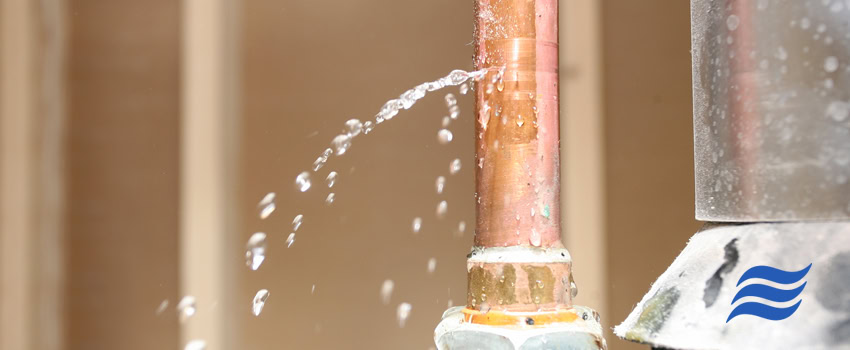
7 Warning Signs of Hidden Plumbing Leaks in Your Northern Virginia Home
The most damaging leaks are often the ones you can't see. While a dripping faucet or overflowing toilet is immediately noticeable, hidden plumbing leaks can go undetected for months or even years, silently causing extensive damage to your Northern Virginia home.
At Nichols & Phipps, we've been helping homeowners solve plumbing problems since 1972, and we've seen firsthand how even small hidden leaks can lead to major structural damage, hazardous mold growth, and thousands in repair costs.
The good news? Your home will usually give you subtle warning signs long before a hidden leak causes catastrophic damage – if you know what to look for.
Why Early Leak Detection Matters
Before we dive into the warning signs, let's understand why catching leaks early is so critical:
- A small leak can waste thousands of gallons of water annually, inflating your utility bills
- Hidden moisture creates the perfect environment for toxic mold growth
- Water gradually weakens structural elements like floor joists, wall studs, and ceiling supports
- Water damage restoration costs far more than early leak repair
- Many insurance policies won't cover damage from long-term leaks that should have been addressed
In Northern Virginia homes, certain factors make hidden leaks particularly common: our region's hard water accelerates pipe corrosion, significant seasonal temperature changes stress plumbing systems, and many local homes have aging pipes approaching the end of their useful life.
Now, let's explore the seven key warning signs that might indicate a hidden leak in your home.
Sign #1: Unexplained Increases in Your Water Bill
Your water bill is often the earliest indicator of a hidden leak. Most households establish relatively consistent water usage patterns, so when your bill suddenly increases without explanation, it's time to investigate.
What to look for: An increase of 20% or more compared to the same month last year, or a steady rise over several months with no change in usage habits.
Why it happens: Hidden leaks continuously waste water, even when you're not home or actively using fixtures. Even a small leak can waste hundreds of gallons of water per day, significantly impacting your utility bills!
Common culprits: While indoor plumbing is often the source, don't overlook your irrigation system. Sprinkler systems are frequent causes of water bill spikes, especially since they typically operate in early morning hours (4-6 AM) when broken heads or leaks go unnoticed. Underground drip systems can also be punctured by gardening tools or invaded by root systems.
DIY check: Review your water bills from the past year. Look for gradual increases or sudden spikes. Your water utility company may provide usage history online, making it easier to spot trends. If you see a significant spike but find no signs of leaks inside your home, inspect your sprinkler system by running each zone and walking around the yard to look for broken heads, unusual pooling, or abnormally lush areas.
EXPERT TIP: “If your bill has increased by more than 20% without explanation, perform a water meter test. Turn off all water-using fixtures and appliances in your home, note your meter reading, and check again after 2-3 hours. If the reading has changed, you likely have a leak somewhere in your system.” – Fred Nichols, Master Plumber
Sign #2: Reduced Water Pressure
Adequate water pressure is something many homeowners take for granted – until it's not there. A noticeable drop in pressure often signals a problem in your plumbing system.
strong>What to look for: Weaker flow from faucets, showerheads running with less force, or multiple fixtures losing pressure when used simultaneously.
Why it happens: Water escaping from a supply line leak means less water reaches your fixtures. The larger the leak, the more dramatic the pressure drop.
DIY check: Compare the water flow from different fixtures in your home. Is the reduced pressure isolated to one area (suggesting a localized leak) or affecting the entire house (potentially indicating a mainline issue)?
EXPERT TIP: “Check if low pressure occurs in both hot and cold water lines. If it's only affecting hot water, the issue might be with your water heater rather than a hidden leak. If pressure drops are sudden and severe, call a plumber immediately – this could indicate a major pipe failure.” – Nichols & Phipps Service Team
Sign #3: Sounds of Water Running When Fixtures Aren't in Use
Your home should be relatively quiet when no one is using water. Unexpected water sounds when fixtures aren't in use often indicate a leak.
What to look for: Listen for hissing, dripping, or rushing water sounds inside walls, under floors, or in ceilings. Pay special attention to sounds that continue when all water-using appliances are off.
Why it happens: Water escaping from pressurized pipes makes distinctive sounds as it sprays, drips, or flows through building materials.
DIY check: Turn off all water-using appliances and fixtures in your home. Walk slowly through each room, pausing to listen near walls containing plumbing. Pay special attention to areas under bathrooms, around water heaters, and near washing machines.
EXPERT TIP: “The best time to listen for water sounds is late at night when your home is quiet and water usage is minimal. If you hear constant running water or intermittent dripping when everything is off, it's time to call a professional. These sounds rarely go away on their own and usually indicate a developing problem.” – Nichols & Phipps Service Team
Sign #4: Mold or Mildew Growth in Unusual Places
Mold needs moisture to grow, so unexplained mold growth often signals a hidden water source – like a leaking pipe. Usually, you'll smell the problem before you see it.
What to look for: Black, green, or brown spots on walls or ceilings, especially in areas not exposed to obvious moisture. Also, watch for mold in unusual places like closets, along baseboards, or behind furniture. A persistent musty odor is frequently the first warning sign before visible mold appears.
Why it happens: Hidden leaks create damp environments inside walls, under floors, or above ceilings – perfect conditions for mold growth.
DIY check: Follow your nose if you detect musty smells – they're often your first clue to hidden moisture problems. Then, look for mold in areas away from typical moisture zones (like direct shower splash). Pay special attention to corners of rooms, especially those adjacent to bathrooms, kitchens, or laundry areas.
EXPERT TIP: “While some mold growth is common in shower areas, finding mold on walls adjacent to bathrooms or on first-floor ceilings beneath second-floor bathrooms almost always indicates a hidden leak. Don't just clean the mold – find and fix the water source, or it will keep coming back. And never ignore musty odors – we've found serious leaks in garage ceilings, behind storage areas, and other rarely inspected spaces based on smell alone.” – Nichols & Phipps Service Team.
Sign #5: Warping or Discoloration of Walls, Floors, or Ceilings
Water damage leaves visible traces on your home's surfaces if you know what to look for.
What to look for:
- Walls: Bubbling or peeling paint/wallpaper, staining, or warping
- Ceilings: Yellowish-brown water stains, sagging areas, or bubbling paint
- Floors: Buckling or warping wood, loose tiles, or damp carpeting
- Baseboards: Swelling, discoloration, or softening
Why it happens: Building materials like drywall, wood, and ceiling tiles absorb water from hidden leaks, causing them to change shape, color, and texture.
DIY check: Regularly scan walls and ceilings for changes in appearance, paying special attention to areas below bathrooms and around plumbing fixtures. Press gently on suspicious spots – water-damaged materials often feel soft or spongy.
EXPERT TIP: “Water stains often appear darker around the edges with lighter centers. They typically indicate a leak directly above or behind the stain. In Northern Virginia's older homes, we often find these stains in ceilings below second-floor bathrooms with aging wax rings or caulk failures.” – Fred Nichols, Master Plumber
Sign #6: Unusually Damp or Lush Areas in Your Yard
Your yard can provide valuable clues about buried water or sewer line leaks.
What to look for: Patches of grass that are greener or growing faster than surrounding areas, unexplained puddles, or soggy spots that don't dry out after rain.
Why it happens: Leaking underground water lines provide extra irrigation to nearby plants. Sewer line leaks feed nutrients to grass, creating unusually lush growth.
DIY check: Walk your yard, noting any unusually green or wet areas, especially along the path where your main water line or sewer line runs from the street to your home.
EXPERT TIP: “In Northern Virginia's clay soils, underground leaks sometimes create a sinkhole or depression as water erodes the soil beneath. If you notice a suddenly appearing low spot in your yard, especially between your home and the street, have it checked immediately.” – Nichols & Phipps Service Team
Sign #7: Musty Odors That Persist Despite Cleaning
Sometimes, you can smell a hidden leak before you can see it.
What to look for: Persistent musty, earthy, or moldy smells that remain even after thorough cleaning. These odors often become stronger in humid weather.
Why it happens: Hidden moisture creates perfect conditions for mold and mildew growth, which produce distinctive musty odors. Leaking sewer lines can also create unpleasant smells.
DIY check: Follow your nose to locate the strongest source of the odor. Check for any of the other warning signs in that area.
EXPERT TIP: “If musty odors seem stronger when your HVAC system runs, check areas near air returns for hidden moisture. In some cases, air circulation can distribute odors from a leak throughout your home, making the source harder to pinpoint without professional equipment.” – Nichols & Phipps Service Team
How Professional Leak Detection Services Work
When these warning signs appear, but you can't pinpoint the source, professional leak-detection services can help. At Nichols & Phipps, our leak detection process includes:
- Comprehensive inspection of all visible plumbing areas
- Pressure testing to identify supply line leaks
- Acoustic leak detection using specialized equipment to “listen” for hidden leaks
- Thermal imaging to detect temperature differences caused by water leaks
- Moisture meter testing to confirm suspicious areas
- Video camera inspection for sewer and drain line leaks
These methods allow us to locate hidden leaks precisely without unnecessary demolition, saving you time and money on detection and repair.
Take Action Before Small Leaks Become Big Problems
Hidden plumbing leaks rarely resolve themselves – they only get worse with time. If you've noticed any of these warning signs in your Northern Virginia home, don't wait for visible water damage to appear.
At Nichols & Phipps, we've been helping Northern Virginia homeowners detect and repair hidden leaks since 1972. Our experienced technicians have the specialized equipment and local knowledge needed to locate leak sources quickly and accurately.
When it's broken, we fix it. When it's unfixable, we replace it. When it's working, we keep it that way – no commissions, no gimmicks, just honest home-repair help so you can get back to running your house and living your life.
Call us today at (703) 670-8519 or visit us online to schedule a professional leak detection service, or visit our comprehensive guide to Residential Plumbing Leaks 101 for more information on protecting your home from water damage.
